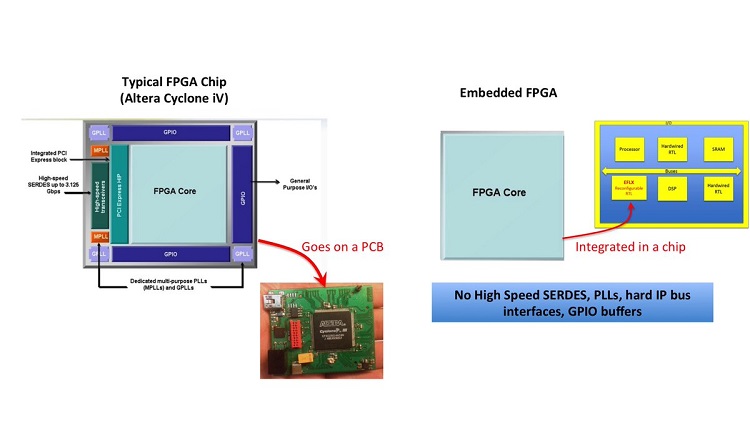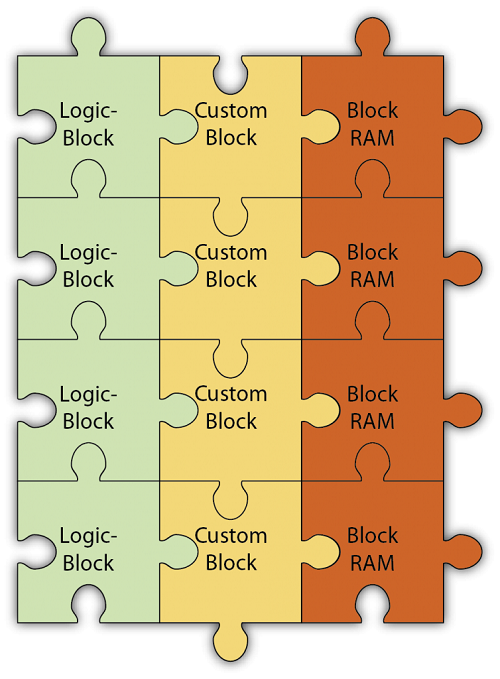By Majeed Ahmad, contributing editor
What’s next in the FPGA technology realm? If the flurry of design announcements in technology media tells you anything, it’s that the time for the embedded FPGA or eFPGA has finally come. Achronix Semiconductor calls 2017 the breakout growth year for the eFPGA technology.
The San Jose, California-based chip firm claims that that’s when its revenue grew 700% year-over-year and that its headcount increased by 30% in 2017. Other semiconductor outfits pushing the eFPGA initiative include Flex Logix, Menta, and QuickLogic.
The FPGA lite technology is promising to combine the ASIC design efficiency with FPGA’s flexibility for incorporating hardware accelerators on a single chip. And that allows engineers to change the configuration or firmware of the chip later on to meet the changing needs of the design.

This is how an eFPGA (right) differs from a conventional FPGA. Image Credit: Flex Logix.
The ecosystem around the eFPGA technology is quickly evolving as firms like QuickLogic start offering evaluation boards for testing their eFPGA IP products. Likewise, Achronix offers the rigorous bench and ATE verification of its Speedcore IP built into chips manufactured on the TSMC 16-nm FinFET+ process node.
QuickLogic has also released the Aurora software for the evaluation of its ArticPro eFPGA IP designed into GlobalFoundries process nodes. Both GlobalFoundries and TSMC have vowed to incorporate the eFPGA technology into their design toolsets.
What’s an eFPGA?
It allows system-on-chip (SoC) designers to embed the FPGA core without incorporating typical FPGA components such as GPIO, SerDes, and PHY. And that eliminates the need for I/O used to connect FPGA to the host device. Moreover, it allows SoCs to be customized after production without expensive and time-consuming redesign efforts.
In other words, chip designers can keep the hard-wired portion of their ASIC intact while updating the FPGA portion whenever needed. Timothy Saxe, CTO of QuickLogic, says that it can save nearly 40% in development costs. Other benefits of adopting the eFPGA approach include smaller die size, lower power consumption, and as mentioned above, post-production design flexibility.

A view of custom blocks of Achronix’s Speedcore eFPGA IP.
The FPGA densities range from less than 10,000 look-up tables (LUTs) to up to 2 million LUTs plus large amounts of embedded memory and DSP blocks. What an eFPGA device does here is allow SoC designers to define custom functions that can be added as additional blocks in the eFPGA fabric.
That, in turn, enables chip designers to create reprogrammable hardware accelerators in order to address changing standards and thus future-proof their designs. The SoC developers can specify their logic, memory, and DSP resource needs and then configure the eFPGA IP according to their particular needs. Next, the LUTs, RAM blocks, and DSP resources can be assembled like building blocks to create the optimal programmable fabric for a specific application.
eFPGA applications
The eFPGA solutions are penetrating the hardware accelerator market for offloading CPU data processing tasks in the data center, 5G wireless, and other high-performance computing applications. Here, the eFPGA-based hardware accelerators significantly expand the range of compute tasks for machine learning, artificial intelligence, and software-defined networks.
The eFPGAs can also be used in sensor fusion tasks to run sensor hub operations at low power budgets, allowing the main CPU to focus on data-processing operations. That’s why developers are targeting eFPGAs at wearable, hearable, and other ultra-low-power IoT applications.

The block diagram showing a QuickLogic eFPGA incorporated into a sensor hub SoC.
The fundamental idea of integrating the FPGA resources into an SoC has been around for many years. According to QuickLogic’s Saxe, it’s the rise in die cost as well as SoC development cost that have finally thrust eFPGAs into the commercial mainstream.
On the other hand, Achronix CEO Robert Blake relates the eFPGA takeoff to the arrival of 16-nm designs. Achronix has been evangelizing the eFPGA technology since 2012. Blake also claims that Achronix’s Speedcore was the first eFPGA IP being shipped to the market.
Nevertheless, the advent of eFPGA shows that the spirit of innovation is alive and well in the semiconductor industry. Furthermore, smaller silicon business outfits like Achronix and Flex Logix are bucking the trend, and that’s a testament that size doesn’t matter when it comes to design innovation.
Advertisement
Learn more about Electronic Products Magazine





